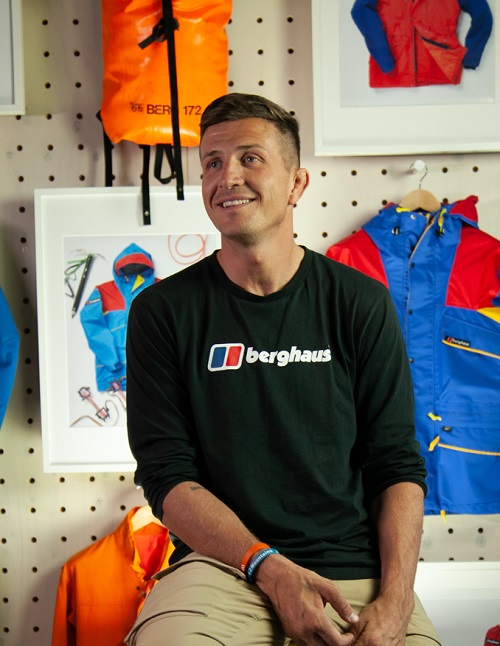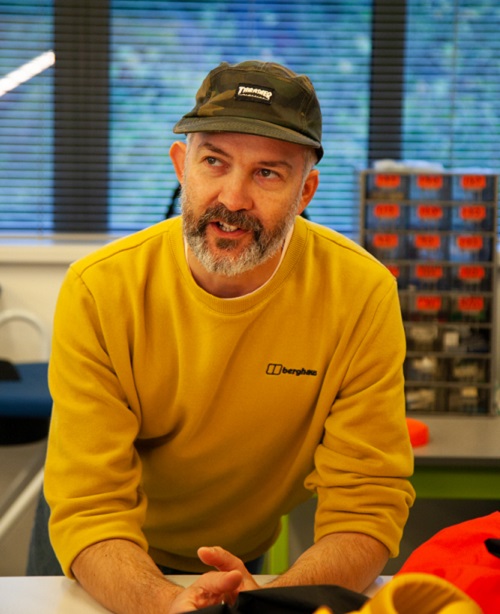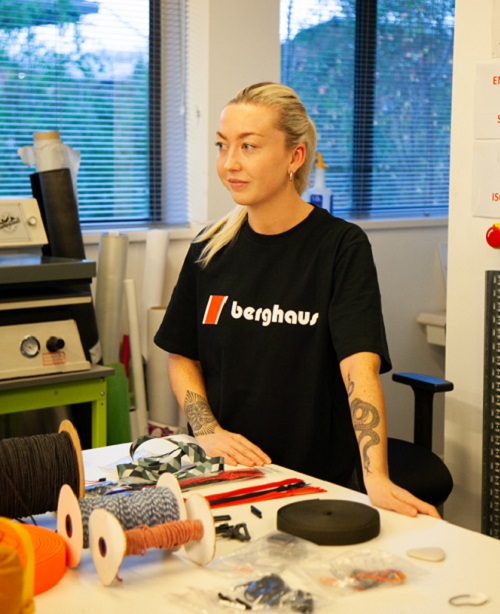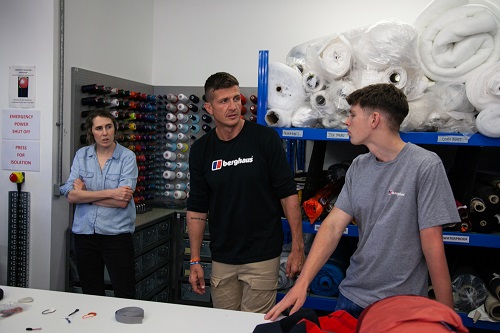In 2017, Ed Jackson suffered a horrific accident in a swimming pool that changed his life completely. The former No 8, who played for Wasps and Dragons, dived into a shallow swimming pool and suffered extensive spinal injuries which ended his rugby career and left him paralysed. Four years on and we were lucky enough to chat with this most extraordinary man – rugby player turned mountaineer – who since his accident has climbed mountains, set up a charity, and collaborated with Berghaus to create his new range, Berghaus Adapts. Here’s Ed Jackson, in his own words.
“I find that it’s the unseen side of disability that affects people the most…”
Ed, in 2017 you had a life-changing accident and since then have been on a hugely inspiring journey. Can you talk us through it?
My injury happened in 2017, and up until that point I had spent 10 years as a professional rugby player so it was kind of chalk and cheese, going from being a professional athlete to the complete opposite pretty much in an instant. I broke my neck diving into a swimming pool and I was left completely quadriplegic from the shoulders down. It was pretty serious; I was resuscitated three times in the ambulance, and after a week I had no movement or sensation return even after the operation. They told me that I was never going to walk again; I was facing my life as fully quadriplegic.
My arms are affected as well because it was a neck break, so obviously that was a pretty scary time. Luckily, through a lot of hard work, I’m where I am today – not just from me but from the amazing support of those around me. I feel there was also a lot of luck involved. Because of the nature of the injury, it meant that there was still something to work with, so things started coming back. My toe wiggled first. After 4 months I left hospital in a wheelchair, by 9 months I was starting to take steps, and by 12 months I climbed Snowdon. It’s been progressive from there, and that was four and a half years ago now.

Rugby was obviously out of the window and that was all I’d ever known since I was a kid. I obviously have spinal cord injury and I also have Brown-Sequard Syndrome which means my spinal cord was cut in half (from 12 to 6 millimetres wide). Brown-Sequard Syndrome is a neurological condition. It only affects 1% of spinal cord injuries, and it means on my left side I have poor mobility but good sensation and on the right hand side I’ve got better mobility but poor sensation, and then I have all the underlying health issues with a spinal cord injury.
So bladder problems, bowel problems, sexual function issues, temperature regulation issues, spasms, and lack of sleep. That’s the stuff that really affects people day to day. I find that it’s the unseen side of disability that affects people the most – the mental health impact is hard. It’s unseen disability that often makes the most difference. People see me limping around, but actually, you get used to limping around. So I just feel lucky that I can limp around, but it’s those other health conditions that can really impact your wellbeing.
Can you tell us more about the challenges of facing difficulties that aren’t just physical, but cognitive as well?
Yeah that mental side is massive. Physically, most people can still go out in some way or another as there are accessible places that people can go in wheelchairs (there should be more), but the issue is people losing confidence to get out the house and actually doing things like that. Then that has a compounding negative effect; say if you have had a stroke or a disability, then you take a knock anyway and all of a sudden you can’t do the things you used to be able to do. We all know how beneficial it is to get out and get fresh air for your mental health anyway, so if you’re also stuck in the house it makes things so much worse.
So, can you tell us about how the collaboration with Berghaus came about to create your new range, Berghaus Adapts?
It happened organically because it got to where my disability was seriously limiting me, as it does anyway. But it got to the point where I thought, if I don’t adapt some stuff I’m not going to be able to go any further, so I came to Berghaus with a few ideas. First thing was a knee loop on the trousers so that I could move my leg in deeper snow. I can’t pick my leg up vertically, so I was having to do one step at a time but if I have a knee loop I can pick my leg up and move forward. And then from there it just snowballed. They asked what else we could do, so we spoke about temperature regulation with the jackets, and since coming back from Mont Blanc recently we’ve come back with loads of new ideas.
They are just ideas I had but then when you’ve got people like Leo and Adrian watching, they come up with more ideas. And a lot of the issues I face are quite common, not in terms of spinal cord injury in the outdoors, but say temperature regulation and bladder weakness. I wear a catheter bag when I’m climbing, and this is something that effects people in older age too. So having access points to get to the bag and things like that, I started thinking well, hang on, this will help me but maybe this will help a lot more people too. Naturally our beneficiaries have their own barriers to the outdoors, a lot of them being physical, so we’re working with them now to come up with different ideas and adaptations that might help with their specific issues.


Like with the jackets designed to help with temperature regulation, the access point is designed to help with the bladder issues, you know. So a lot of the adaptive kit isn’t necessarily for the obvious, you know, the knee loop is to help me move my leg that doesn’t move. That’s pretty obvious to the eye, but a lot of the kit adaptations are actually for things that you might not see.
The mobility stuff as well – spinal cord injury is not common, but stroke is really common and anything like that will put people off going outdoors because it’s that extra effort. So hopefully this is not just setting an example by going out and doing these things having had a disability, but by also creating kit and having the backing of a big outdoor brand to say ‘no, we want you outdoors too’ – it’ll just encourage more people to give it a go.
Going through what you’ve experienced must feel quite isolating, especially because products like these aren’t readily available currently. So knowing that you have Berghaus and people who are willing to help and take the time to research, I guess it would make you feel more motivated as well?
Yeah, absolutely. So how I got in contact with Berghaus was I wanted to climb bigger mountains after Snowdon. A year after my accident, when I climbed Snowdon, I did it for a few reasons. One was to give myself something to aim for. So I was doing six hours of physio a day, I didn’t know when the end of my rehab would be and I needed a goal to sort of work towards. The second reason was to repay one of the charities that have been supporting me since I left hospital, so I wanted to give all that money back.


But the third reason was to sort of set an example for other people who were in hospital who have been given a guarded or negative prognosis, and maybe that doesn’t have to be the case. And that’s what I wanted to do on the one-year mark. Even though my physio thought I was mad, because I’d only taken my first steps three months before, I was like, even if I don’t get to the top, if people see me walking or even attempting to climb a mountain a year after being told I’d never walk again, then at least it sends a message that it might be possible for other people. But then when I did it, I got to top of Snowdon.
“It was the first time I’d felt like I can do something useful again, as ever since I’d finished playing rugby, I’d lost my purpose completely.”
I’ve always been quite outdoorsy. But only to the point where I live in the countryside, and also my grandparents owned a farm. So I spent a lot of time on the farm, but never out climbing mountains. I remember standing on top of Snowdon after like nine hours of pushing myself to the top, surrounded by other people who would come along to join and who are going through their own things, or just wanted to support. It was the first time I’d felt like I can do something useful again, as ever since I’d finished playing rugby, I’d lost my purpose completely.

That must have been incredibly tough but also so rewarding. Tell us more about your transition into climbing mountains and your charity ‘Millimetres to Mountains’.
So I was like, I don’t know how my future is going to go. But it’s got to involve mountains and other people who are going through stuff. Six months later, I’d started ‘Millimetres to Mountains’. We take people who are struggling with their mental health as a result of trauma, so whether that be physical or psychological, we’ve taken people away with PTSD. Also people with spinal cord injuries or car crashes – all sorts of things. We recognise that actually, it’s not about the physical disability, it’s the mental side and getting someone happy again – it’s as though you’re filling someone with purpose again. And I didn’t want to make it just about spinal cord injuries, it’s about using the outdoors to give people some drive again, make people realise it’s not just them and that there is a future.
“…at the time, I thought it was the end, but actually, it’s turned out to be the beginning.”
We were planning a trip to Nepal later that year, to visit a spinal unit over there. And I remember speaking to one of my mates about it. He said that his Dad had a friend who worked at Pentland, so we should speak to Berghaus about maybe sorting a bit of kit out to see if they could support and give us a few jackets. And we just so happened to be climbing Mera Peak, which obviously is a famous Berghaus jacket, which I had no idea at the time. In fact, when I first phoned Berghaus, I picked up the phone and I was so surprised to hear someone with your accent. I thought I’d be speaking to Germany or something, you know.
That’s how naive I was, you know, a couple of years ago. But since then, it’s just developed and they’ve been absolutely amazing. They kitted out our charity to go to Nepal, but since then, it’s just developed so organically and there’s no written relationship; it’s always just been Berghaus wanting to support me. And now hopefully, as things are growing and progressing, I can give some of that back by telling the story of how amazing they’ve been to help me. No one knew what we were doing or who we were when they first set out to help us. It’s been completely organic, and I owe them a huge amount.


And now this adaptation piece, which again has organically come out of the needs of myself and the charity, is just another incredible story. They told us just before we went to Mont Blanc with Leo, that they wanted to extend it to our beneficiaries, and potentially the scope to extend it further than that, for other people. I mean, it’s just amazing.
But my life has moved in so many weird and wonderful ways since I broke my neck, which is the really weird thing, because at the time, I thought it was the end, but actually, it’s turned out to be the beginning. Like, the fact I’ve written a book, you know, it’s absolutely mad. If I told myself that five years ago, I would have just laughed at myself, you know, and then the charity TV stuff!
And no matter how tough things seem, at the time, there’s always a chance to move forward in different directions, if you can accept the position you’re in and try and move in the right direction. And that’s the message that we give to our beneficiaries.
I once came to our beneficiaries and I realised how lucky I was with my support network – having Berghaus, having the rugby community, having amazing family and friends. I used to take that for granted, but I realised that not everyone has that. And I almost felt guilty for it a little bit. So that’s why I wanted to set up the charity and help other people who are in a position that want to help themselves, but don’t have the network to do it. So to have Berghaus now involved with the whole process with the charity, not just as ‘here’s some kit’ sort of way, but actually actively helping in different ways, is truly incredible.

